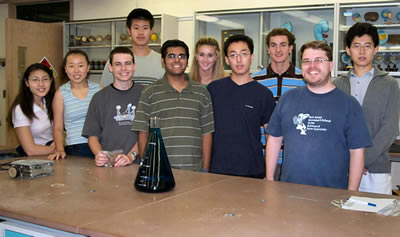 |
New Jersey Governor's School in the Sciences at Drew University |
 |
Drew Links |
|
| Team Projects | |
| NJGSS Home | |
| About NJGSS | |
Related Links |
|
| Drew University | |
2004 Team 2 |
|||||||||||
CHEMICAL ANALYSIS OF TREES INFESTED BY THE ASIAN LONGHORNED BEETLEMegan Choy, Michele Edelmann, Louis Kang, Yushen Qian, Craig Schindewolf, Robert Vitt, Bill Zhang, and Rachel Zhang |
|||||||||||
ABSTRACT This study investigated the possible role of certain aspects of tree chemistry and anatomy in the attraction and sustenance of the Asian Longhorned Beetle (Anoplophora glabripennis) pest. Trees in the experimental group included Northern Red Oak (Quercus rubra), Shagbark Hickory (Carya ovata), Sugar Maple (Acer saccharum), and Willow (Salix sp.), all known targets of the Asian Longhorned Beetle (ALB). An evergreen control, Eastern Pine (Pinus Strobus), was also present. Some aspects of tree chemistry tested include reducing sugar content, protein content, and lignin content. A feature of tree anatomy that was examined was total cross-sectional vessel area relative to total cross-sectional area of the stem. The team hypothesized that reducing sugar content, protein content, and the ratio of total vessel area to total area of the stem cross-section would have a positive correlation with degree of known beetle infestation, while the lignin content would will have negative correlation. The study found that experimental data of sugar, protein, and lignin content yielded inconclusive results. It found a slight positive correlation with vessel area, but more studies are needed to verify the significance of this finding, retest for sugar, protein, and lignin concentration, and investigate other variables such as tree extractives, seasonal effects on tree chemistry, and interdependence of all variables. |
|||||||||||
|
Team 2 |
||||||||||
